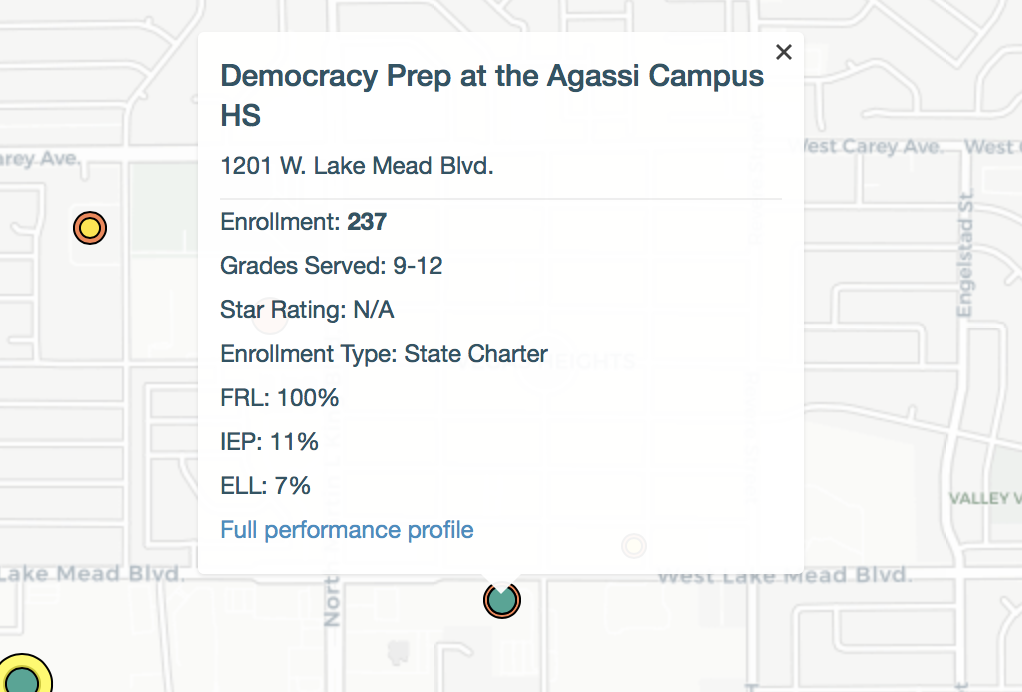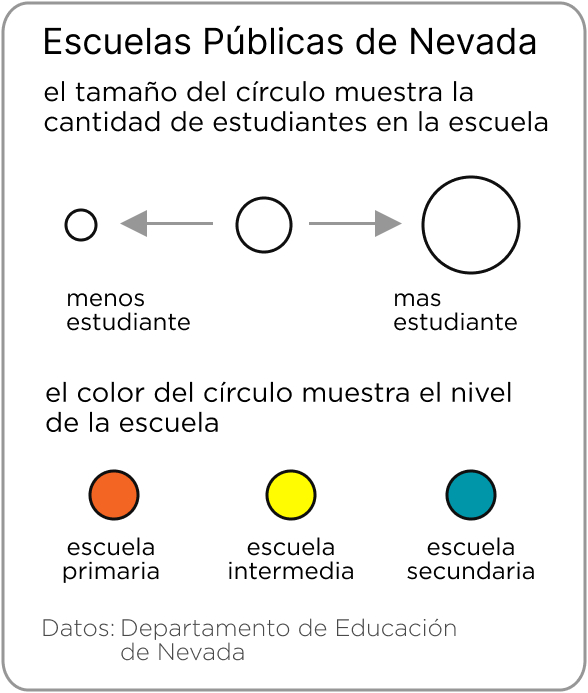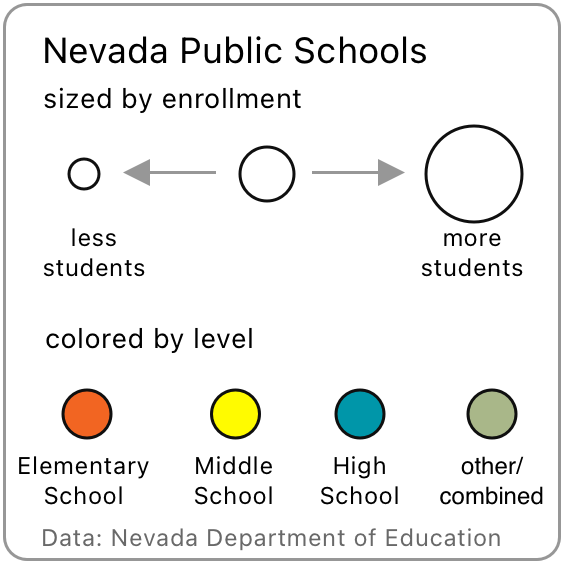
Welcome to the Nevada Public School Quality Map!
This interactive map was designed to demonstrate where the highest- and lowest-performing K-12 public schools, district and charter, are located across Nevada.
In addition to displaying geographic location and enrollment sizes, this map also allows users to access a snapshot of student population makeup by subgroup, view schools located in Opportunity Zones, and narrow schools within their county districts.
SCHOOL SNAPSHOT
Click on a school bubble to see a snapshot profile, including a link to access a full school performance data profile on our School Scout Nevada data tool.

FRL: Students from households that qualify by income to receive free or reduced-price lunch at their school. Economically disadvantaged students have historically been identified as those from low-income families, earning below 185 percent of the federal poverty line.
ELL: English-language learners (ELL) are students who are unable to communicate fluently or learn effectively in English, who often come from non-English-speaking homes and backgrounds, and who typically require specialized or modified instruction in both the English language and in their academic courses.
IEP: Students on an Individual Education Plan (IEP) are those receiving special education services. For the purposes of the Nevada School Performance Framework, only students who were on an IEP at the time of testing factor into the IEP calculations.
QUICK DEFINITIONS
Congressional District: A Congressional District is a specific region of a state represented by a member of the United States House of Representatives, a part of the U.S. Congress that has the power to pass, amend, and repeal bills that are made into law, and the power to impeach a federal official. Nevada has four congressional districts represented by four members of congress elected for 2-year terms in the U. S. House of Representatives.
Senate Districts: The Nevada Legislature is a public body comprised of elected leaders from communities across the State. Their purpose is to enact laws and regulations for the State of Nevada. The Nevada State Senate is the upper house of the Nevada Legislature with the lower house being the Nevada Assembly. The Senate currently consists of 21 Senators and 42 Assembly members representing Senate Districts and Assembly Districts for specific geographical regions in Nevada. Senate and Assembly District representatives work alongside the governor of Nevada and each other to create laws and establish a state budget, and to pass bills on public policy and other matters.
Trustee District: A Trustee District is a specific geographic region that is represented by a Board of Trustees, a group of elected community leaders that make decisions about public education in Nevada. The Board of Trustees establishes policies for and employs and evaluates the performance of the superintendent of their school district.
Opportunity Zones: An Opportunity Zone is a community or certain neighboring area that is identified by the State as low-income, defined by population census tracts. Opportunity Zones were created under the 2017 Tax Cuts and Jobs Act. Communities that qualify are nominated by the State and certified by the U.S Department of the Treasury.
RESOURCES
Data sources:
The Nevada Department of Education, Nevada School Performance Framework (NSPF)
For a full map of Nevada Assembly Districts and Representatives, click here.
For a full map of Nevada Senate Districts and Representatives, click here.
View information about school district Trustees:

¡Bienvenido al Mapa de la Calidad de Escuelas Públicas del Estado de Nevada!
Este mapa interactivo fue diseñado para ofrecer a los miembros de la comunidad la oportunidad de ver dónde están las escuelas k-12 de alto y bajo rendimiento en el Condado Clark.
Además de mostrar la ubicación geográfica y un registro de las inscripciones, este mapa también permite a los usuarios acceder a una vista previa de la composición de la población estudiantil por subgrupos, ver las escuelas ubicadas en las Zonas de Oportunidad y las escuelas catalogadas como restringidas dentro de los distritos de su condado.
RESUMEN DE LA ESCUELA
Haga clic en una burbuja de la escuela para ver un perfil instantáneo, incluido un enlace para acceder a un perfil completo de datos de rendimiento escolar en nuestra herramienta de datos.

FRL: Estudiantes de hogares que califican por ingreso para recibir almuerzo gratis a precio reducido en su escuela. Los estudiantes económicamente desfavorecidos históricamente han sido identificados como aquellos de familias de bajos ingresos, que ganan menos del 185 por ciento de la línea de pobreza federal.
ELL: Estudiantes que están aprendiendo inglés (ELL) son estudiantes que no pueden comunicarse con fluidez o aprender efectivamente en inglés, que a menudo provienen de hogares y entornos que no hablan inglés, y que generalmente requieren instrucción especializada o modificada tanto en inglés como en sus cursos académicos.
IEP: Estudiantes en un Plan Educativo Individualizado (IEP) son esos estudiantes que están recibiendo servicios de educación especial. Para los propósitos del Marco de Desempeño Escolar de Nevada, únicamente los estudiantes que estaban en un IEP en el momento de los exámenes están incluidos en los cálculos de IEP.
DEFINICIONES RÁPIDAS
Distrito del Congreso – Un Distrito del Congreso: Un Distrito del Congreso es una región específica de un estado representado por un miembro de la Cámara de Representantes de los Estados Unidos, una parte del Congreso de los Estados Unidos que tiene el poder de aprobar, enmendar y revocar proyectos de ley que se convierten en ley, y el poder de impugnar a un funcionario federal. Nevada tiene cuatro distritos del Congreso representados por cuatro miembros del Congreso elegidos por períodos de 2 años en la Cámara de Representantes de los Estados Unidos.
Distritos del Senado: La Legislatura de Nevada es un organismo público compuesto por líderes electos de las comunidades de todo el estado. Su propósito es promulgar leyes y regulaciones para el estado de Nevada. El Senado del Estado de Nevada es la cámara alta de la Legislatura de Nevada y la cámara baja es la Asamblea de Nevada. El Senado actualmente consta de 21 senadores y 42 miembros de la Asamblea que representan distritos del Senado y distritos de la Asamblea para regiones geográficas específicas en Nevada. Los representantes del Senado y del Distrito de la Asamblea trabajan junto con el gobernador de Nevada y entre ellos para crear leyes y establecer un presupuesto estatal, y aprobar proyectos de ley sobre políticas públicas y otros asuntos.
Distrito de Fideicomisarios: Un Distrito de Fideicomisarios es una región geográfica específica que está representada por una Junta de Fideicomisarios, un grupo de líderes comunitarios electos que toman decisiones sobre la educación pública en Nevada. La Mesa Directiva establece políticas y emplea y evalúa el desempeño del superintendente de su distrito escolar.
Zonas de Oportunidad: Una Zona de Oportunidad es una comunidad o cierta área vecina que el estado identifica como de bajos ingresos, definida por secciones censales de población. Las Zonas de Oportunidad se crearon bajo la Ley de Empleos y Reducción de Impuestos de 2017. Las comunidades que califican son nominadas por el estado y certificadas por el Departamento del Tesoro de EE. UU.
RECURSOS
Fuente de datos:
Departamento de Educación de Nevada, Nevada School Performance Framework (NSPF))
Para obtener un mapa completo de los distritos y representantes de la Asamblea de Nevada, haga clic aquí.
Para ver un mapa completo de los distritos y representantes del Senado de Nevada, haga clic aquí.
Ver información sobre Los Fideicomisarios del distrito escolar:

Maligayang Pagdating sa Nevada School Quality Map!
Ang interactive na mapang ito ay idinisenyo upang ipakita kung saan matatagpuan ang pinakamataas at pinakamababang-performing na K-12 pampublikong paaralan, distrito at charter sa buong Nevada.
Sa karagdagan ipinapakita nito ang heyograpikong lokasyon at enrollment sizes, pinapayagan din ng mapang ito ang mga user na ma-access ang isang snapshot ng populasyon ng mga mag-aaral ayon sa subgroup, makita ang mga paaralang matatagpuan sa Opportunity Zones at makikitid na paaralan sa loob ng kanilang mga distrito.
SNAPSHOT NG ESKWELAHAN
I-click ang school bubble upang makita ang snapshot profile, kabilang na ang isang link upang ma-access ang buong school performance data profile sa aming data tool na School Scout Nevada.

FRL: Ang mga estudyante sa mga sambahayan na kuwalipikado ayon sa kanilang income ay maaring makatanggap ng libre or pinakamababang presyo ng tanghalian sa kanilang paaralan. Ang mga economically disadvantaged na estudyante ay mula sa mga pamilyang may mababbang kita, kumikita ng mas mababa sa 185% ng Federal Poverty Line.
ELL: Ang English-language learners (ELL) ay ang mga estudyanteng hindi makapagsalita ng mabuti o hindi epektibong natututo sa Ingles, na kadalasan lumalaki sa isang non-English na tahanan, at karaniwang nangangailangan ng espesyal o modified na pagtuturo sa parehong wikang Ingles at sa kanilang mga kursong akademiko.
IEP: Ang mga estudyante sa isang Individual Education Plan (IEP) ay ang mga tumatanggap ng espesyal na serbisyong pang-edukasyon. Para sa layunin ng Nevada School Performance Framework, ang mga estudyante na nasa isang IEP sa panahon ng testing factor para sa IEP calculations.
QUICK DEFINITIONS
Congressional Districts: Ang Congressional District ay isang partikular na rehiyon ng isang estado na kinakatawan ng isang miyembro ng United States House of Representatives, bahagi ng U.S. Congress na may awtoridad na magmagpasa, baguhin at bawiin ang mga panukalang-batas na isinagawang mga batas, at ang kapangyarihang i-impeach ang isang pederal na opisyal. Ang Nevada ay may apat na congressional district na kinakatawan ng apat na membro ng kongreso na inihalal ng dalawang taong termino sa U.S. House of Representative.
Sentate Districts: Ang Nevada Legislature ay isang public body na binubuo ng mga nahalal na pinuno mula sa iba’t ibang parte ng estado. Ang layunin nito ay isabatas ang mga batas para sa State ng Nevada. Ang Nevada State Senate ay ang upper house ng Nevada Legislature at ang lower house bilang ang Nevada Assembly. Ang Senado ay kasalukuyang binubuo ng 21 Senador at 42 miyembro ng Assemby na kumakatawan sa mga Senate Districts at Assembly Districts para sa mga partikular na heograpikong rehiyon ng Nevada. Ang mga kinatawan ng Senate at Assembly District ay nagtratrabaho kasama ang gobernador ng Nevada at sabay na gumagawa ng mga batas, magtatatag ng State budget at nagpapasa ng mga panukalang batas sa pampublikong patakaran at iba pang mga bagay.
Trustee Districts: Ang Trustee District at isang partikular na heograpikong rehiyon na kinatawan ng Board of Trustees, grupo ng mga nahalal na pinuno ng mga komunidad na gumagawa ng desisyon ayon sa pampublikong edukasyon sa Nevada. And Board of Trustees ang nagtatag ng mga patakaran at employs at sinusuri ang performance ng superintendent ng kanilang school district.
Opportunity Zones: Ang Opportunity Zone ay isang komunidad o ilang kalapit na lugar na kinikilala ng estado na may mababang kita ayon sa sensus ng populasyon. Ang Opportunity Zones ay ginawa sa ilalim ng 2017 Tax Cuts and Jobs Act. Ang mga komunidad na kwalipikado ay nominado ng estado at sertipikado ng U.S. Department of Treasury.
RESOURCES
Data sources:
The Nevada Department of Education, Nevada School Performance Framework (NSPF)
For a full map of Nevada Assembly Districts and Representatives, click here.
For a full map of Nevada Senate Districts and Representatives, click here.
Tingnan ang impormasyon ng school district trustees:
